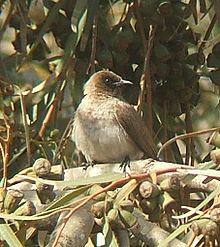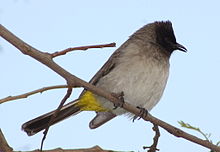- Common Bulbul
-
Common Bulbul 
Nominate subspecies
Oued Massa National Park, MoroccoConservation status Scientific classification Kingdom: Animalia Phylum: Chordata Class: Aves Order: Passeriformes Family: Pycnonotidae Genus: Pycnonotus Species: P. barbatus Binomial name Pycnonotus barbatus
(Desfontaines, 1789)The Common Bulbul (Pycnonotus barbatus) is a member of the bulbul family of passerine birds. It is a ubiquitous resident breeder throughout Africa. Other names include Black-eyed Bulbul and Common Garden Bulbul.
Contents
Taxonomy
The bulbuls are a widespread family of songbirds, found much over Africa and Asia.
The Common Bulbul has a number of subspecies; some authorities consider P. b. dodsoni (Dodson’s Bulbul), P. b. somaliensis (Somali Bulbul) and P. b. tricolor (Dark-capped Bulbul) as separate species from the nominate P. b. barbatus.
Identification
The bill is fairly short and straight. The bill, legs and feet are black and the eye is dark brown with a dark eye-ring, which is not readily visible.
The Dark-capped Bulbul is mostly greyish-brown above and whitish-brown below, with a distinctive dark head and pointy crest on top of the head. The back of the head merges into the brown of the back, and the chin is also blackish. The underparts are grey-brown apart from white around the vent (yellow in P. (b.) tricolor). It is about 18 cm in length, with a long tail. It has a dark brown head and upperparts. Sexes are similar in plumage.
Habitat and breeding
It is a common resident breeder in much of Africa. It is found in woodland, coastal bush, forest edges, riverine bush, montane scrub and in mixed farming habitats. It is also found in exotic thickets, gardens and parks.
This species nests throughout the year in the most tropics, elsewhere it is a more seasonal breeder with a peak in breeding co-inciding with the onset of the rainy season. The nest is fairly rigid, thick walled and cup-shaped. It is situated inside the leafy foliage of a small tree or shrub.
Two or three eggs is a typical clutch. It, like other bulbuls, is parasitised by the Jacobin Cuckoo.
Behaviour
The Black-eyed Bulbul is usually seen in pairs or small groups. It is a conspicuous bird, which tends to sit at the top of a bush. As with other bulbuls they are active and noisy birds. The flight is bouncing and woodpecker-like. The call is a loud doctor-quick doctor-quick be-quick be-quick.
Diet
This species eats fruit, nectar and insects.
References
- BirdLife International (2004). Pycnonotus barbatus. 2006. IUCN Red List of Threatened Species. IUCN 2006. www.iucnredlist.org. Retrieved on 12 May 2006. Database entry includes justification for why this species is of least concern
- Birds of The Gambia by Barlow, Wacher and Disley, ISBN 1-873403-32-1
- http://www.birdlife.org.za/fieldguide/book/species_info.php?id=192
External links
- Common Bulbul videos, photos & sounds on the Internet Bird Collection
- Common Bulbul on avibase
- Common Bulbul on IBC
Categories:- IUCN Red List least concern species
- Pycnonotus
- Birds of Africa
Wikimedia Foundation. 2010.


